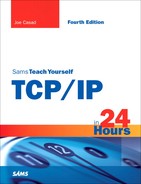The Semantic Web
A promising area of research that truly might cause another Internet revolution is an ambitious concept known as the semantic web. The semantic web, which has the full support and advocacy of World Wide Web creator Tim Berners-Lee, is designed as a universal technique for linking web data with real semantic meaning as a human understands it. In other words, the goal is to somehow encode the meaning of web information in a way that is easily accessed and processed by a computer.
To understand the purpose of the semantic web, one must start with some sense of how little knowledge is truly present on a web page. For instance, consider the following lines of text, which might be present at a typical website:
A Streetcar Named Desire
Lawrence Community Theater
Saturday, October 12, 2008
7:30 PM
A human who looks at this text knows immediately that it is a notice of an event that will occur at the Lawrence Community Theater at 7:30 on October 12. Many readers will also recognize the name A Streetcar Named Desire as a famous play, but those who don’t recognize the title will still infer that the event is a play or movie because it is associated with a theater.
A computer, on the other hand, will just read those lines as alphanumeric text. The computer doesn’t really know anything about the meaning of the text. It doesn’t know what a theater is, and it doesn’t know that the third line is a date unless you specifically tell it so. For that matter, a search engine will even call up this page for a user who is searching for a streetcar schedule.
The tools of the semantic web will one day help the web developer encode semantic information so that an automated process will know that this page is about a play and not about a ticket for a tram ride. Because this semantic information will be encoded along with the page itself, the creator of the site won’t need any advance knowledge of how the reader will use the information. Anyone can come along later and create a tool that searches for information on plays, and the tool will find the notice of this play. Different websites can present the information differently, with no standard format or style, and the play finder application will still find the plays—as long as the semantic information defines the meaning of the text.
Semantic web techniques are still experimental, although several strategies have appeared in the publications of the World Wide Web Consortium (W3C). One semantic web tool that has received considerable attention in the web community is called the Resource Description Framework (RDF). RDF is a framework for expressing relationships that give an indication of meaning. The fundamental unit of RDF is a statement consisting of three parts, which is called a triple in RDF parlance. A triple is structured like a basic sentence, which has a subject, a predicate, and an object.
For instance, in the sentence “The play has the title A Streetcar Named Desire,” the subject is “The play,” the object is “A Streetcar Named Desire,” and the predicate is “has the title.”
RDF triples can take on several forms, but the idea is that each element is expressed as a URI, and the URIs are concatenated in a colon-separated list. The Dublin Core Metadata Initiative maintains a database of standard predicates referenced in RDF triples. For instance, the following callout
<http://purl.org/dc/elements/1.1/title>
refers to the predicate “has the title.”
RDF and other semantic web techniques might someday lead to smarter search tools.
